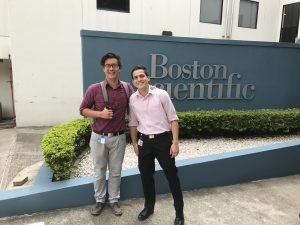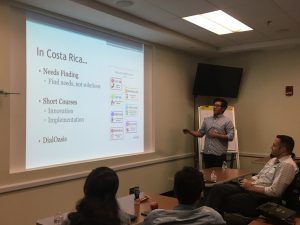I was just recently video chatting with a friend back in the states, and it was incredible to hear about her new position as an ophthalmic technician in Boston. She described her busy work schedule, how she already had begun working with patients in as little as her second day, and how she has made new friends along the way. But what was fun to watch was how excited she was to start this new chapter in her life, how ecstatic she was to work at a job she loved (even if it may require a two-hour nap at the end of the week). In that same capacity, I am even more enthusiastic than I was a week ago to work with Boston Scientific and the R&D Neuromodulation team in Heredia, Costa Rica. The environment, the work, the ambition; it has kept me focused on my ultimate goal of improving patients’ quality of life. It is what I envisioned my goal as a biomedical engineer to be, so let me take you back through my first days at Boston Scientific.
Firstly, what is neuromodulation, and why do you care for it?
We walk, talk, eat, and (sometimes) sleep, often for granted. This is because at a cellular level within our bodies, neurons release chemicals to regulate surrounding populations of neurons. Dopamine, serotonin, histamine, norepinephrine…sound familiar? These neuromodulators in your central nervous system help regulate your motor system, your mood, your appetite to eat, among many more important bodily functions. Unfortunately, with increasing age or simply through genetics, some of these neurons may deteriorate and even die, increasing the risk in pathologies we recognize today as essential tremor, rigidity, and Parkinson’s disease (PD). Neuromodulation is an emerging class of medical therapies that targets the nervous system through electrical stimulation to alleviate these pathologies. The results are nothing but extraordinary, and if you need further convincing, this video just might do the trick .
25 years ago, my grandmother noticed the slight tremors in her hands, and for the 22 years of my life, I have seen the debilitating and catastrophic effects that Parkinson’s disease can have on a person and a family. What started as trembles has now evolved to a loss of strength, a lack of appetite, and a woman who continues to fight her own body against all odds.
To give a brief background, I chose to be a biomedical engineer in a family of accountants and business management professionals. Though an unfamiliar decision, my dad smiled when I made my choice and said that one day I could invent a device to help my grandmother, the woman who fought her own diagnosis to raise me. In some way, he must be smiling right now because he was right. Working with neuromodulation is the penultimate introduction to my career as a biomedical engineer, as it captures the essence of my ambition to help people such as my grandmother and the other 10 million people who suffer from PD. In that regard, I am determined to make a difference during my internship here.
So, what have you been up to?
Working in a company as large and as well-known as Boston Scientific comes with its pros and cons. On one end, it took nearly the entire week to file all the proper paperwork and get my name in the system, but with the assistance of very diligent IT personnel, it was all resolved quickly. On the other end, I jumped right into my work on the very first day with some of the brightest minds in the field. Working in a purely R&D setting, every person contributes in their own way to a part of the project, ultimately leading to a successful product for patients. In fact, with resources at Boston Scientific being as endless as space itself, the only limitation is your creativity to try new things.
With devices as complex as implantable pulse generators (IPGs), which are the devices used to generate the electrical stimuli for deep brain stimulation (DBS) and spinal cord stimulation (SCS), it is easy to see how being an expert in a certain subsystem of a project can be more beneficial than trying to modify an entire system. In my case, I am working on ways to improve the interaction between the charger and the IPG, which can be optimized to reduce the time it takes to charge the device. To better understand the important factors that drive the efficiency of the system, I will be developing a fully adjustable model that considers those factors. Not only will this lead our efforts to enhance device functionality, but it will also change the way patients view charging their IPG, as it currently seems like an inconvenience and requires a lot of time to do so.
Where do you go from here?
As we dive into our second week of our internship, I am really excited to engage with the other neuromodulation personnel at Boston Scientific. Many were out of town last week, but working with them and getting their insights this upcoming week will help advance my project as well as my understanding of the problem statement. There is still a lot to learn about the process and the devices that we use, but I am confident that I will fit right in with the creative and dynamic minds of R&D.
But Chan, do you do anything other than work?
Sure. I’ll be posting a video soon, but here are a few photos of our times at the Cataratas (waterfalls) this past Saturday!




